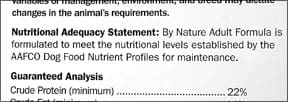Not all that long ago, selecting a dry food for your dog was pretty simple. What brand (singular) did your local pet supply store carry? What size bag did you want? And would you like some help out with that, ma’am?
Today, making a choice of dry dog foods can be immensely more complex that is, if you buy into the notion that not all “complete and balanced” diets are equal. There are millions of people, after all, who think that all dog foods are alike, and that you’d have to be an idiot to spend $30 or $40 or $50 on the same-sized sack of what you can buy for $7.99 at WalMart.
We’re here to testify that there is a difference between those $7.99 foods and the high-dollar products. And, while the task isn’t exactly brain surgery, choosing the best foods for your dog requires your attention and consideration of numerous factors.
First things first
Our task today is to dispense with a common misconception one so prevalent, that even many veterinarians swear it’s accurate. Many people believe that all dog foods that are labeled as “complete and balanced” are equally appropriate and healthful for your dog. It’s so not true.
“Complete and balanced” sounds good unambiguous in its assertion that a product so labeled contains everything, in just the right amounts and proportions, that a dog needs to live a long and healthy life. But, as Bob Dylan sings, “The truth was far from that.”
In reality, there is a huge amount of variation in the nutrient levels of pet foods that are labeled “complete and balanced.” I’d like to start taking the quotation marks off that expression, believe me, but I just can’t. The phrase must be taken with a handful of salt. Yet few ever stop to question how it’s possible for a food containing, say, 42 percent protein and 22 percent fat (like Innova Evo), to be just as “complete and balanced” as a food containing 21 percent protein and 4 percent fat (like Purina Kibbles and Chunks).
Maybe you’re okay with that; maybe you expect to see disparity in the amounts of macro-nutrients (protein and fat) in dog foods, especially since there is so much variety in their ingredients. It may surprise you to learn, though, that there is also a wide range of micro-nutrient (vitamin and mineral) levels represented in different “complete and balanced” dog foods.
And it may shock you to learn that a food can be labeled as “complete and balanced” even if it contains nutrient levels that are deficient, excessive, or imbalanced enough to cause illness in a dog fed a sole diet of that food for a number of years! I’ll explain how this is possible and you’ll see why I can’t take the quote marks off the phrase in question.
Which test did it pass?
Pet foods can earn the right to use the “complete and balanced” nutritional adequacy statement in one of three ways: by successfully completing a feeding trial, by meeting the “nutritional levels” requirements as set by the Association of American Feed Control Officials (AAFCO), or through a so-called “family member.”

288
No matter which method is used to prove its adequacy, the “complete and balanced” claim must specify the population of dogs the food is supposed to be able to sustain: adult dogs (a “maintenance” claim); puppies (“growth”); gestating or lactating females; or dogs in “all life stages” (all of the above).
In an AAFCO feeding trial, the candidate product is fed to a minimum number of dogs for a specified period. For the food to pass the trial, no more than 25 percent of the dogs can be removed from the study for “non-nutritional reasons or for poor food intake.” No dog in adult studies can lose more than 15 percent of its body weight during the trial. In the trials that include puppies, the pups must gain specified percentages of weight. The test dogs must also pass other fairly liberal tests of their “health.” (Note: We described feeding trials in much more detail in “On Trial,” April 2005.) If the food passes, it gets to carry a statement that looks like this:
The second way for a food to earn the “complete and balanced” appellation is to demonstrate (through laboratory analysis) that the food contains a concentration of nutrients that meets all the minimum levels, and does not exceed the maximum levels, of certain nutrients determined by AAFCO to be necessary to maintain the intended canine consumers. If all of the values for each required nutrient fall into the ranges approved by AAFCO, the food gets to carry a statement that looks something like this:
You could say that nepotism is the third method of achieving “complete and balanced” status. If a manufacturer can demonstrate that a new product bears a “nutritional similarity” to one of its products that has already passed an “all life stages” feeding trial, the new “family member” can be labeled with the same feeding trial claim.

288
Problems with each test
Each method of qualifying for a nutritional adequacy claim has its faults, to wit:
– Foods that pass feeding trials are not required to contain minimum or maximum levels of any particular nutrients. Therefore, it’s possible for a food to sustain dogs long enough to “pass” the trial, but fail to demonstrate an ability (in real-world, long-term use) to promote optimum health. As one example, mineral excesses may take a year or more to cause noticeable health problems, but a food that claims to provide complete and balanced nutrition for adult dogs (a “maintenance” claim) may have passed only a 26-week test.
There is also an AAFCO feeding trial (at least 13 weeks long) for products intended for dogs during gestation and lactation and another that tests puppy diets (10 weeks). To earn the right to claim nutritional adequacy for dogs of “all life stages,” a food must undergo all three trials sequentially, for a total of 49 (or more) weeks. If it passes, its label can state, “Animal feeding tests using AAFCO procedures substantiate that (name of product) provides complete and balanced nutrition for all life stages.”
Many experts regard the “all life stages” feeding trial as the best proof we have of a food’s ability to perform. But again: Even a year-long feeding trial may fail to reveal faults that can cause serious health problems if fed as a sole diet for a long period.
– Foods that meet the “AAFCO nutritional profiles” qualification can lack palatability and/or digestibility. If dogs don’t like the smell or taste of the food, they won’t eat enough of it to gain its nutritional benefits. Also, the nutrients contained in a product may not be present in a form that the dog can digest. The AAFCO nutrient profiles themselves contain a problem: Not many lay people are aware that the profiles allow for a wide range of values. Far from being some sort of industry “standard,” or offering suggestions for optimum nutrition, they actually offer only broad guidance.
The profiles outline minimum values for each nutrient currently proven to be required for dogs. Also included are maximum values for eight minerals and three vitamins, out of concern for potential toxicosis if excessive levels of those nutrients are fed.
The spread between the allowed minimum and maximum values reveals just how far the industry is from consensus about “ideal” nutrient levels or, perhaps, how little research has been conducted in this area.
This latter explanation is actually offered by AAFCO itself, to explain why more maximum nutrient levels are not defined: “The absence of a maximum should not be interpreted to mean that those nutrients are safe at any level. Rather, it reflects the lack of information on nutrient toxicity in dogs and cats. Establishing a maximum level implies safety below that level and to set a maximum arbitrarily might prove worse than no maximum at all.”
One of the most striking gaps occurs in the levels allowed for iron. The minimum value is 80 mg per kg; the maximum is 3,000 mg/kg. One can well imagine that a food containing something near the minimum will perform very differently from one containing an amount closer to the maximum allowable level.
These profiles are better than nothing; they get a pet food maker into the ballpark. But in our opinion, it’s farcical to qualify all the products with such a wide range of nutrient levels as “complete and balanced” especially with the common mistaken inference that all the products carrying that statement are somehow equal.
– Foods that use the “family member” route to qualification are not required to be distinguished from the family member that actually passed the “all life stages” feeding trial. This seems like the sneakiest path to a nutritional adequacy claim. There is no way for a consumer to learn which food in a manufacturer’s “family” was the “lead” product the one that actually passed the feeding trial and which ones are hanging on its coattails. Imagine: a food that is identified as having met the most stringent test, without having been tested at all.
The concern here is that a food might appear “nutritionally similar” enough to its lead product to garner access to the approved “family,” while lacking some vital characteristic that was key to its predecessor’s success.
Other claims you might see
There are a few other claims seen on pet food labels. Here is an interesting one:
If the label states that the food is “intended for intermittent or supplemental feeding only,” it can mean the maker really intends for the food to supplement other products, that it really isn’t complete or balanced. But the statement is also used sometimes when the food has some nutritional values that are out of the range of the AAFCO profiles, and it hasn’t yet passed a feeding trial. Here is another:

288
Notice anything missing? It’s lacking the AAFCO reference! Without referencing either the AAFCO nutritional values or AAFCO feeding trials, it has to be lumped into the category of products that carry no statement about their completeness. In these cases, you are totally on your own.

288
Final consideration
One last thing: Feeding trials (especially the three sequential trials needed to garner an “all life stages” claim) are wildly expensive. The pet food industry giants have the resources to conduct these trials routinely, and as a result, most of their foods carry the “feeding trials” claim. Again, this statement carries the most weight with many veterinary nutritionists (even though the food may not meet all the AAFCO “nutritional levels” values). Smaller, independent companies the ones that make the foods we tend to like often conduct their own, informal feeding tests to work out palatability and digestibility issues, but can’t easily afford to conduct AAFCO-protocol trials. That’s why many products on our “top foods” list carry the “nutritional levels” claim.
Compare for yourself!
We hope we’ve inspired you to go take a gander at that last bag of dog food you bought or, more importantly, to examine the labels of several foods before you buy the next bag. We’ve been busy examining labels ourselves. On the following pages, we’ve listed dry dog foods that meet our selection criteria. Our methodology is described in “Whole Dog Journal’s Dry Dog Food Selection Criteria,” right. Regarding our list of foods, please also consider the following:
– the foods on our list are not the only good foods! The list is offered as a starting place and for its value as a comparison to products you may find in your area.
As an addendum to this point, if the variety we describe doesn’t suit your needs, check its maker’s website or call their toll-free phone number to get information about the other varieties in the same line.
– We have presented the foods on our list alphabetically. We do not “rank order” foods. We don’t attempt to identify which ones are “best,” because what’s “best” for every dog is different.
– The proof is in the pudding. If your dog does not thrive on the food, with a glossy coat, itch-free skin, bright eyes, clear ears, and a happy, alert demeanor, it doesn’t matter whether we like it or not.
And if your dog’s health or attitude sours under the influence of a certain food, stop feeding it, note the ingredients, and find another food that contains different ingredients. Keep your notes! Sometimes it takes several years of detective work to find products that really suit your dog.
– Remember that quality comes with a price. These foods may be expensive and difficult to find. Contact the maker and ask about purchasing options. If the customer service representatives are less than helpful, move on to another product. As you’ll see from our list on the following pages, there are plenty from which to choose.






